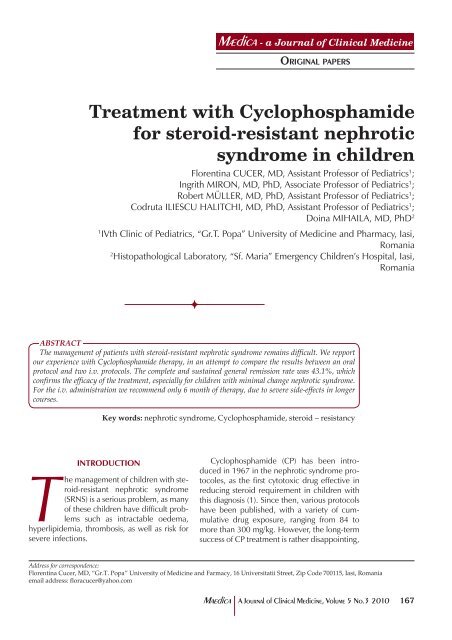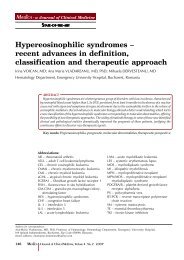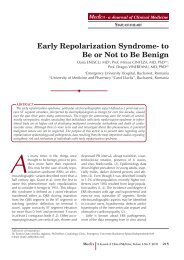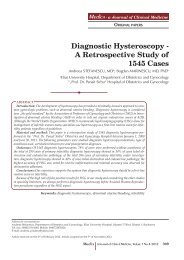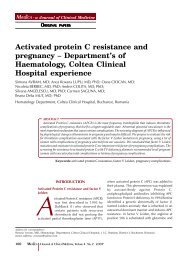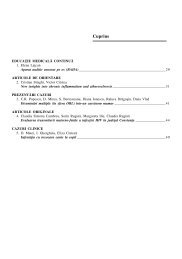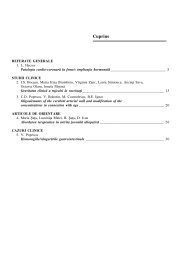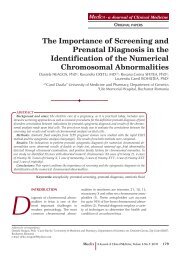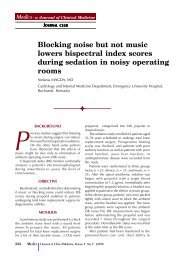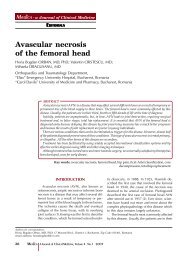Treatment with Cyclophosphamide for steroid-resistant nephrotic ...
Treatment with Cyclophosphamide for steroid-resistant nephrotic ...
Treatment with Cyclophosphamide for steroid-resistant nephrotic ...
You also want an ePaper? Increase the reach of your titles
YUMPU automatically turns print PDFs into web optimized ePapers that Google loves.
MK pg 167<br />
Mædica - a Journal of Clinical Medicine<br />
ORIGINAL PAPERS<br />
<strong>Treatment</strong> <strong>with</strong> <strong>Cyclophosphamide</strong><br />
<strong>for</strong> <strong>steroid</strong>-<strong>resistant</strong> <strong>nephrotic</strong><br />
syndrome in children<br />
Florentina CUCER, MD, Assistant Professor of Pediatrics 1 ;<br />
Ingrith MIRON, MD, PhD, Associate Professor of Pediatrics 1 ;<br />
Robert MÜLLER, MD, PhD, Assistant Professor of Pediatrics 1 ;<br />
Codruta ILIESCU HALITCHI, MD, PhD, Assistant Professor of Pediatrics 1 ;<br />
Doina MIHAILA, MD, PhD 2<br />
1<br />
IVth Clinic of Pediatrics, “Gr.T. Popa” University of Medicine and Pharmacy, Iasi,<br />
Romania<br />
2<br />
Histopathological Laboratory, “Sf. Maria” Emergency Children’s Hospital, Iasi,<br />
Romania<br />
ABSTRACT<br />
The management of patients <strong>with</strong> <strong>steroid</strong>-<strong>resistant</strong> <strong>nephrotic</strong> syndrome remains difficult. We repport<br />
our experience <strong>with</strong> <strong>Cyclophosphamide</strong> therapy, in an attempt to compare the results between an oral<br />
protocol and two i.v. protocols. The complete and sustained general remission rate was 43.1%, which<br />
confirms the efficacy of the treatment, especially <strong>for</strong> children <strong>with</strong> minimal change <strong>nephrotic</strong> syndrome.<br />
For the i.v. administration we recommend only 6 month of therapy, due to severe side-effects in longer<br />
courses.<br />
Key words: <strong>nephrotic</strong> syndrome, <strong>Cyclophosphamide</strong>, <strong>steroid</strong> – resistancy<br />
INTRODUCTION<br />
The management of children <strong>with</strong> <strong>steroid</strong>-<strong>resistant</strong><br />
<strong>nephrotic</strong> syndrome<br />
(SRNS) is a serious problem, as many<br />
of these children have difficult problems<br />
such as intractable oedema,<br />
hyperlipidemia, thrombosis, as well as risk <strong>for</strong><br />
severe infections.<br />
<strong>Cyclophosphamide</strong> (CP) has been introduced<br />
in 1967 in the <strong>nephrotic</strong> syndrome protocoles,<br />
as the first cytotoxic drug effective in<br />
reducing <strong>steroid</strong> requirement in children <strong>with</strong><br />
this diagnosis (1). Since then, various protocols<br />
have been published, <strong>with</strong> a variety of cummulative<br />
drug exposure, ranging from 84 to<br />
more than 300 mg/kg. However, the long-term<br />
success of CP treatment is rather disappointing,<br />
Address <strong>for</strong> correspondence:<br />
Florentina Cucer, MD, “Gr.T. Popa” University of Medicine and Farmacy, 16 Universitatii Street, Zip Code 700115, Iasi, Romania<br />
email address: floracucer@yahoo.com<br />
Maedica A Journal of Clinical Medicine, Volume 5 No.3 2010<br />
167
MK pg 168<br />
TREATMENT WITH CYCLOPHOSPHAMIDE FOR STEROID-RESISTANT NEPHROTIC SYNDROME IN CHILDREN<br />
due to a poor remission rate after 5 years and<br />
to well known adverse effects, including the<br />
oncological risk (2).<br />
We report our experience on the effectiveness<br />
of CP in children <strong>with</strong> SRNS. <br />
METHODS<br />
We per<strong>for</strong>med a retrospective study in 51<br />
children <strong>with</strong> idiopathic SRNS who have<br />
been treated <strong>with</strong> CP in the IVth Clinic of Pediatrics<br />
from Iasi, beginning from 1994 to the<br />
end of 2009. We included 45 patients <strong>with</strong> primary<br />
<strong>steroid</strong>-resistance and 6 patients <strong>with</strong> secondary<br />
<strong>steroid</strong>-resistance. Only patients who<br />
received at least 2 months of oral CP or 3 pulses<br />
of i.v. CP and those followed <strong>for</strong> at least 1<br />
year were included.<br />
The treatment <strong>with</strong> CP was introduced after<br />
4 weeks of Prednisone course 2 mg/kg/day and<br />
3 alternative boluses of Methilprednisolone 30<br />
mg/kg/day.<br />
1.<br />
2.<br />
3.<br />
4.<br />
We considered the next parameters:<br />
age at onset of <strong>nephrotic</strong> syndrome<br />
the hystopathological spectrum of renal biopsies<br />
the treatment duration and the cumulative<br />
dose per kilogram of body weight, in case of<br />
oral and intravenous treatment<br />
the evolution after therapy <strong>for</strong> those patients<br />
followed <strong>for</strong> at least one year.<br />
We used CP in a dose of 2 mg/kg/day, daily,<br />
<strong>for</strong> oral treatment (protocol I), 400 mg/m2/<br />
dose, i.v. in monthly boluses, 6 months (protocol<br />
II), and 400 mg/m2/dose, i.v. in monthly<br />
boluses, 6 months, followed by 3 boluses at 3<br />
months interval (protocol III).<br />
Associated medication during CP consisted of<br />
alternate-day Prednisone, in a tapered dosage.<br />
We considered as a good response – remission<br />
– the absence of proteinuria <strong>for</strong> 3 consecutive<br />
days and, as persistent remission, at least<br />
6 months of survey <strong>with</strong> absent proteinuria<br />
from the end of therapy <strong>with</strong> CP.<br />
Statistical analysis was per<strong>for</strong>med using the<br />
SPSS 16.0 <strong>for</strong> Windows. A p value of less then<br />
0.05 was defined to indicate a significant difference.<br />
<br />
RESULTS<br />
The age at the onset of <strong>nephrotic</strong> syndrome<br />
varied between 13 and 192 months, <strong>with</strong> a<br />
mean of 99.14 months, and 2 frequency picks<br />
at 84 and 168 months.<br />
Renal biopsies were per<strong>for</strong>med only in 47<br />
cases be<strong>for</strong>e initiation of oral or i.v. treatment<br />
<strong>with</strong> CP. The hystological findings included:<br />
• mesangioproliferative glomerulonephritis<br />
(MesPGN) – 22 patients (43,1%),<br />
• minimal change <strong>nephrotic</strong> syndrome<br />
(MCNS) – 9 patients (17.6%),<br />
• membranous nephropathy (MN) – 8 patients<br />
(15.7%),<br />
• focal segmental glomerulosclerosis<br />
(FSGS) – 4 patients (7.8%),<br />
• membranoproliferative glomerulonephritis<br />
(MPGN) – 4 patients (7.8%).<br />
Patients and treatment characteristics, according<br />
to the hystopathological spectrum and<br />
response to the therapy <strong>with</strong> CP, are shown in<br />
Table I.<br />
The cumulative dose of CP varied between<br />
26.6 and 490.9 mg/kg, <strong>with</strong> a mean of 104.59<br />
mg/kg. The duration of treatment <strong>with</strong> CP varied<br />
according to the protocol type. We treated<br />
9 children <strong>with</strong> protocol I (17.6%), 24 children<br />
<strong>with</strong> protocol II (47.1%), and 18 children <strong>with</strong><br />
protocol III (35.3%).<br />
There is significant correlation between the<br />
age of children at the onset of <strong>nephrotic</strong> syndrome<br />
and the protocol we used (p=0.027).<br />
Also, there is a strong correlation between the<br />
protocol type and the cumulative dose of CP<br />
(p=0.001), the cumulative dose being higher<br />
<strong>for</strong> the patients treated <strong>with</strong> protocol I. Twentytwo<br />
patients (43.1%) experienced a sustained<br />
remission while on CP therapy and one year<br />
after the onset of treatment, whereas 29 children<br />
(56.9%) had only clinical or no remission.<br />
There is no correlation between the histological<br />
type and remission of the SRNS (p=0.258).<br />
Complete remission was noted in 11.8% of<br />
patients under protocol I, in 17.6% of patients<br />
under protocol II, and in 13.7% of patients under<br />
protocol III.<br />
The adverse effects noted in our cases were:<br />
leukopenia (1 patient), acute chemical cystitis<br />
(1 patient), allopecia (1 patient) and two cases<br />
<strong>with</strong> severe infections (tuberculous serositis – 1<br />
patient, primary peritonitis – 1 patient). <br />
DISCUSSION<br />
Only a small percentage of the children<br />
<strong>with</strong> <strong>nephrotic</strong> syndrome fail to enter in<br />
remission <strong>with</strong> Prednisone, the question being<br />
about what is the treatment of choice <strong>for</strong> that<br />
specific cases.<br />
168 Maedica A Journal of Clinical Medicine, Volume 5 No.3 2010
MK pg 169<br />
TREATMENT WITH CYCLOPHOSPHAMIDE FOR STEROID-RESISTANT NEPHROTIC SYNDROME IN CHILDREN<br />
Protocol I Protocol II Protocol III Total<br />
Number of patients 9 24 18 51<br />
Histopathological findings<br />
-MCNS 1 6 2 9<br />
-MesPGN 3 9 12 24<br />
-MN 2 4 0 6<br />
-FSGS 0 3 1 4<br />
-MPGN 0 1 3 4<br />
- no biopsy 3 1 0 4<br />
Complete remission 6 (11.8%) 9 (17.6%) 7 (13.7%) 22 (43.1%)<br />
TABLE 1. Distribution of patients in our study, according to CP protocol, histology and remission rate<br />
The actual protocols range from alkylating<br />
agents, such as CP or Chlorambucil, to Azathioprine,<br />
or the newer ones as Mycophenolate<br />
mophetil and the calcineurine inhibitors to<br />
clasic i.v. therapies like Methilprednisolone,<br />
<strong>with</strong> or <strong>with</strong>out other alkylating agents (i.v. CP).<br />
Some case series have pondered on the use of<br />
ACE inhibitors such as Lisinopril or Captopril,<br />
and on plasmapheresis (3, 4).<br />
CP is the drug which has been mostly used<br />
in SRNS in our clinic, still remaining the drug of<br />
choice <strong>for</strong> the moment, due to socio-economic<br />
reasons.<br />
We reviewed several case series from international<br />
repports and noticed that, because of<br />
the small number of patients involved different<br />
protocols, it is difficult to conclude weather<br />
there is, or there isn’t any real advantage of one<br />
protocol over another. For instance, <strong>for</strong> the use<br />
of oral CP and Prednisolone, we found only<br />
studies that looked at the outcome at the end<br />
at the therapy course, about 78% of the children<br />
having experienced some improvement,<br />
of which 70% achieved complete remission<br />
(5). The majority (about 60%) of children went<br />
into relapse, actually, after cessation of treatment.<br />
Ehrich had reported complete remission in<br />
25% of SRNS cases, <strong>with</strong> a combination of oral<br />
CP and Prednisone, administered <strong>for</strong> 90 days<br />
(6). In our study there was a poor improvement<br />
rate after oral CP, of only 11.8% complete remission<br />
(protocol I).<br />
The oral administration of CP was used in<br />
our clinic between 1994 and 1998, after that<br />
period being choosed other protocols <strong>with</strong> i.v.<br />
CP (7-9). The use of i.v. CP was also due to the<br />
absence of the oral drug during that period of<br />
time. In our study there was a good response to<br />
CP in children less than 7 years old <strong>with</strong> minimal<br />
change <strong>nephrotic</strong> syndrome, when the cumulative<br />
dose was over 200 mg/kg.<br />
The efficiency of the i.v. administration of<br />
CP varied between different studies, repported<br />
from 40 to 100% of remission (10, 11) after 6<br />
months of therapy. Our remission rate <strong>with</strong><br />
both oral and i.v. protocols is 43.1%, which is<br />
at the lower limit comparative to the international<br />
studies. This could be explained by different<br />
hystopathological aspects and also by<br />
genetic features that we were not able to analyse.<br />
There is concern regarding the long-term effects<br />
of alkylating agents. Sterility has been reported<br />
in patients treated as children, particularly<br />
<strong>with</strong> prolonged or repeated courses.<br />
Therapy <strong>with</strong> alkylating agents has been also<br />
associated <strong>with</strong> an increased risk of neoplasms<br />
(12). For these reasons we advise only 6 months<br />
of treatment <strong>with</strong> i.v. CP.<br />
The duration of follow-up between 12 and<br />
36 months did not allow us to study the longterm<br />
effects of treatment <strong>with</strong> CP. On shortterm<br />
we noted adverse effects only in 5/51<br />
children. <br />
CONCLUSION<br />
<strong>Treatment</strong> <strong>with</strong> CP can still be of an option<br />
<strong>for</strong> the treatment of SRNS, leading to complete<br />
and sustained remission in 43.1% of the cases<br />
included in our study.<br />
The i.v. administration of CP has significantly<br />
better efficiency, when compared <strong>with</strong> the<br />
oral course (31.3% over 11.8%).<br />
For those children, who do not enter into<br />
remission after 6 months of CP therapy, we<br />
strongly recommend to evaluate another therapeutic<br />
option, due to the risk of long-term side<br />
effects of CP.<br />
Maedica A Journal of Clinical Medicine, Volume 5 No.3 2010<br />
169
MK pg 170<br />
TREATMENT WITH CYCLOPHOSPHAMIDE FOR STEROID-RESISTANT NEPHROTIC SYNDROME IN CHILDREN<br />
REFERENCES<br />
1.<br />
2.<br />
3.<br />
4.<br />
Vester U, Kranz B, Zimmermann S,<br />
Hoyer PF – <strong>Cyclophosphamide</strong> in<br />
<strong>steroid</strong>-sensitive <strong>nephrotic</strong>-syndrome:<br />
outcome and outlook. Pediatr Nephrol<br />
2003; 18:661-664<br />
Habashy D, Hodson E, Craig J –<br />
Intervention <strong>for</strong> idiopatic <strong>steroid</strong><strong>resistant</strong><br />
<strong>nephrotic</strong> syndrome: a<br />
systematic review. Pediatr Nephrol 2003;<br />
18:906-912<br />
Okada M, Sugimoto K, Yagi K,<br />
Yanagida H, Tabata N, Takemura T –<br />
Mycophenolate mofetil therapy <strong>for</strong><br />
children <strong>with</strong> intractable <strong>nephrotic</strong><br />
syndrome. Pediatr Int 2007; 49(6):933-937.<br />
Oliveira L, Wang D, McCormick BB –<br />
A case report of plasmapheresis and<br />
cyclophosphamide <strong>for</strong> <strong>steroid</strong>-<strong>resistant</strong><br />
focal segmental glomerulosclerosis:<br />
recovery of renal function after five<br />
months on dialysis. Clin Nephrol 2007;<br />
67(4):250-254.<br />
5.<br />
6.<br />
7.<br />
8.<br />
9.<br />
Gipson DS, Gibson K, Gipson PE,<br />
Watkins S, Moxey-Mims M –<br />
Therapeutic approach to FSGS in<br />
children. Pediatr Nephrol 2007; 22(1):28-<br />
36<br />
Ehrich JH – Steroid-<strong>resistant</strong> idiopathic<br />
childhood nephrosis: overdiagnosed<br />
and undertreated. Nephrol Dial<br />
Transplant 2007; 22 (8):2183-93<br />
Adhikari M, Bhimma R,<br />
Coovadia HM – Intensive pulse<br />
therapies <strong>for</strong> focal glomerulosclerosis in<br />
South African children. Pediatr Nephrol<br />
1997; 11:423-428<br />
Gulati S, Pokhariyal S, Sharma RK,<br />
Elhence R, Kher V, Pandey CM,<br />
Gupta A – Pulse cyclophosphamide<br />
therapy in frequently relapsing<br />
<strong>nephrotic</strong> syndrome. Nephrol Dial<br />
Transplant 2001; 16:2013-2017<br />
Bajpai A, Bagga A, Hari P, Dinda A,<br />
Srivastava RN – Intravenous<br />
10.<br />
11.<br />
12.<br />
cyclophosphamide in <strong>steroid</strong>-<strong>resistant</strong><br />
<strong>nephrotic</strong> syndrome. Pediatr Nephrol<br />
2003; 18:351-356<br />
Hervé C, Dantal J – Possible new<br />
perspectives <strong>for</strong> our understanding of<br />
<strong>nephrotic</strong> syndrome recurrence. Nephrol<br />
Dial Transplant 2006; 21: 10-13<br />
Alshaya HO, Al-Maghrabi JA,<br />
Kari JA – Intravenous pulse<br />
<strong>Cyclophosphamide</strong> – is it effective in<br />
children <strong>with</strong> <strong>steroid</strong>-<strong>resistant</strong><br />
<strong>nephrotic</strong> syndrome? Pediatr Nephrol<br />
2003; 8(11):1143-1146<br />
Alexopoulos E, Stangou M,<br />
Papagianni A, Pantazaki A,<br />
Papadimitriou M – Factors influencing<br />
the course and the response to<br />
treatment in primary focal segmental<br />
glomerulosclerosis. Nephrol Dial<br />
Transplant 2000; 15:1348-1356<br />
170 Maedica A Journal of Clinical Medicine, Volume 5 No.3 2010


